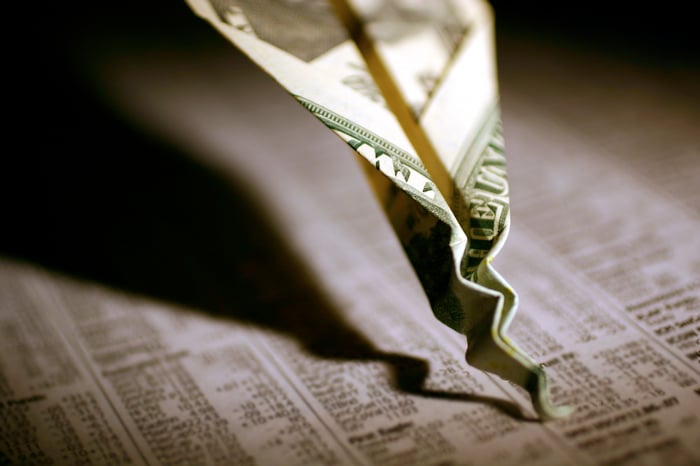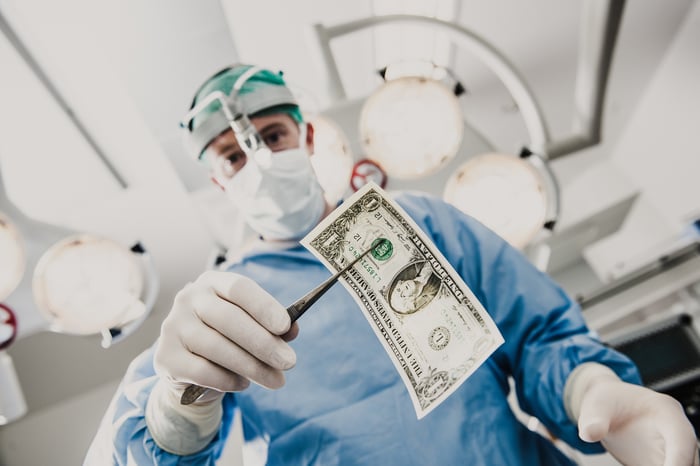For investors, there might not be three words scarier than "stock market crash." With the coronavirus nosedive -- a loss of 34% in the benchmark S&P 500 (^GSPC -1.32%) in 33 calendar days -- still fresh in the minds of most folks, the last thing they probably want to think about is another round of panic selling.
Unfortunately, another stock market crash is inevitable.

Image source: Getty Images.
Like it or not, a crash is coming
Though we'll never be able to precisely predict when a crash will occur, how long it'll last, or how steep the ultimate decline will be, history clearly shows that big declines in the stock market are a normal part of the investing cycle, and the price of admission to one of the greatest wealth creators on the planet.
For example, equity valuations have been ringing alarm bells for some time. At the closing bell on May 24, the S&P 500's Shiller price-to-earnings ratio -- a P/E that examines inflation-adjusted earnings from the previous 10 years -- closed at 37.22. That's more than double the average Shiller P/E ratio since 1870. The bigger concern is that in the previous four instances where the S&P 500's Shiller P/E ratio crossed above 30 and sustained that level, the widely followed index subsequently shed at least 20% of its value.
Additionally, history tells us that rebounds from bear market bottoms are never this smooth. Over the past 61 years, there have been nine bear markets, including the coronavirus crash. In the previous eight bear markets, there were either one or two instances of a double-digit percentage decline in the S&P 500 within three years of hitting a bear-market bottom. Without exception, double-digit declines are normal as the market looks to regain its footing following a bear market.
The capper is that there have been 38 instances where the S&P 500 has dropped by at least 10% since 1950 (once every 1.87 years).
In short, it's inevitable that another stock market crash will occur.
Crashes and corrections are the perfect opportunities to buy great stocks at a discount
On the other hand, history also shows us that each and every crash throughout history has been a major buying opportunity. If you buy great companies at a discount and allow your investment thesis to play out over time, you have a very good chance of building wealth.
When the next stock market crash does arise, consider putting your money to work in these three unstoppable stocks.

Image source: Square.
Square
Fintech stock Square (SQ -2.97%) is aiming to reshape the financial services space. With two exceptionally high-growth segments powering its sails, it can be confidently bought hand over fist during any stock market crash.
Most people are probably familiar with Square's seller ecosystem. If you've ever purchased something from a small merchant, you've possibly used a point-of-sale device from Square. In addition to point-of-sale devices, it provides analytics and loans to help businesses succeed. In the seven years leading up to the pandemic, gross payment volume (GPV) processed on the company's seller ecosystem grew by an average of 49% a year to hit $106 billion in 2019.
The best thing about the seller ecosystem is that it's primarily driven by merchant fees. In other words, the bigger the merchant, the more gross profit Square is likely to generate. Over the past two years, its GPV from businesses generating at least $125,000 in GPV on an annualized basis is up 9 percentage points to 61%.
But the bigger long-term lure for investors is the peer-to-peer digital payments platform Cash App. In three years, Cash App's monthly active user count more than quintupled to 36 million. Cash Card usage is way up (the Cash Card acts like a debit card that pulls from a user's Cash App balance), and gross profit per user is a cool $41. For some context, Square is spending less than $5 to acquire new users. Those are some insane margins that should allow Cash App to become the company's runaway driver of gross profit.

Image source: Getty Images.
Intuitive Surgical
If Wall Street were to put out a dictionary, I'd lobby for Intuitive Surgical's (ISRG -1.58%) company logo to go next to the definition of "unstoppable." This provider of robotic-assisted surgical systems has clear-cut competitive advantages and an operating model primed for margin expansion. A crash would be the perfect time to pick up shares at a discount.
Intuitive Surgical has made a name for itself thanks to the da Vinci surgical system. Surgeons trained to use da Vinci can make more precise incisions than with laparoscopic surgery, often leading to fewer complications and faster recovery time for patients. But what's amazing is that Intuitive has installed over 6,100 of its systems worldwide in two decades. That's far more than any of its competitors on a combined basis.
The company has also seen its sales channels shift more favorably since the 2000s. Early on, most of its revenue was derived from selling its pricey da Vinci systems. The unfortunate part is these are complicated systems to build, which led to only mediocre margins. As time has passed, higher-margin revenue channels now account for the bulk of its sales. This includes selling instruments and accessories with each procedure, as well as servicing its systems. As a result, Intuitive Surgical's income growth should outpace its sales growth over time.

Image source: Getty Images.
Keep in mind that brand-name stocks can still make patient investors a fortune. That's why a stock market crash would be the perfect time to scoop up shares of unstoppable social media behemoth Facebook (META -11.25%).
When the curtain closed on the first quarter of 2021, Facebook had 2.85 billion monthly active users visiting its namesake site and another 600 million unique visitors heading to WhatsApp or Instagram monthly. That's 3.45 billion unique people (about 44% of the world's population) visiting a Facebook-owned asset monthly. Advertisers know full well they can't go anywhere else and get such a broad or targeted audience for their product or service. This is why its ad-pricing power is practically unsurpassed.
What's incredible, though, is that Facebook remains in the early innings of its growth. That might be tough to fathom for a company with almost $86 billion in revenue last year, but it's the truth. While it has monetized its namesake site and Instagram for ad revenue, neither WhatsApp nor Facebook Messenger, two of the most-visited social platforms on the planet, are producing meaningful revenue. When Facebook does open the floodgates on these assets, its sales and operating cash flow should rocket higher.
And that's still not all. Facebook also offers plenty of ancillary revenue opportunities. Its "Other" segment, which includes its Oculus virtual reality (VR) devices, saw revenue grow by 146% in the first quarter to $732 million. Whether it's VR devices, financial services, streaming, or something else, Facebook has ample opportunity to expand its revenue channels beyond advertising.





